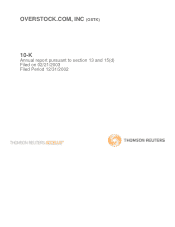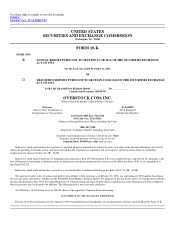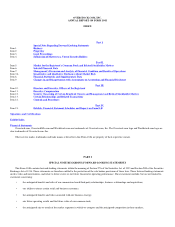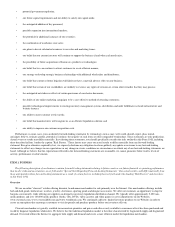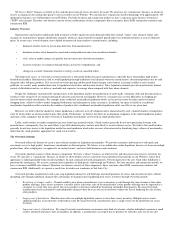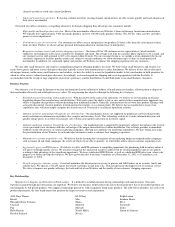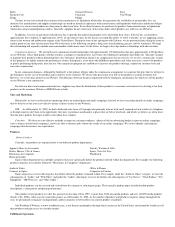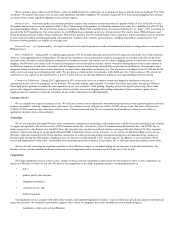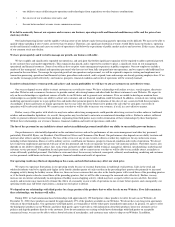Overstock.com 2002 Annual Report Download - page 5
Download and view the complete annual report
Please find page 5 of the 2002 Overstock.com annual report below. You can navigate through the pages in the report by either clicking on the pages listed below, or by using the keyword search tool below to find specific information within the annual report.
We have a "direct" business, in which we buy and take possession of excess inventory for resale. We also have our "commission" business, in which we
receive a commission for selling other parties' excess inventory on our Websites. We currently have commission-based relationships with approximately 150
third parties that post over 4,000 products on our Websites. For both our direct and commission models we have a consumer and a business-to-business
("B2B") sales channel. Therefore, our business consists of four combinations of these components: direct consumer, direct B2B, commission consumer and
commission B2B.
Industry Overview
Manufacturers and retailers traditionally hold inventory to buffer against uncertain demand within their normal, "inline" sales channels. Inline sales
channels are manufacturers' primary distribution channels, which are characterized by regularly placed orders by established retailers at or near wholesale
prices. In recent years, several dynamics have shifted inventory risk from retailers to manufacturers, including:
dominant retailers insist on just-in-time deliveries from manufacturers;
dominant retailers often demand to cancel orders mid-production and return unsold merchandise;
style, color or model changes can quickly turn inventory into closeout merchandise;
incorrect estimates of consumer demand which can lead to overproduction; and
changes in a retailer's financial situation or strategy results in cancelled orders.
The disposal of excess, or overstock, inventory represents a substantial burden for many manufacturers, especially those who produce high-quality
branded merchandise. Manufacturers seek to avoid liquidating through traditional retail channels where the manufacturer's discounted products may be sold
alongside other full-price products. This can result in weaker pricing and decreased brand strength, and is known as channel conflict or sales channel
pollution. As a result, many manufacturers turn to liquidation wholesalers and discount retailers. These liquidation channels provide manufacturers limited
control of distribution and are, we believe, unreliable and expensive to manage when compared with their inline channels.
Despite the challenges encountered by manufacturers in the liquidation market, the proliferation of outlet malls, wholesale clubs and discount chains is
evidence of the strong level of consumer demand for discount and closeout merchandise. However, consumers face several difficulties in shopping for
closeout and overstock merchandise. For example, many traditional merchandise liquidation outlets are located in remote locations and have limited
shopping hours, which we believe makes shopping burdensome and infrequent for many consumers. In addition, the space available in a traditional
merchandise liquidation outlet constrains the number of products that a traditional merchandise liquidation outlet can offer at any given time.
However, we believe that the market for online liquidation is still early in its development and is characterized by only a limited number of competitors,
some of which utilize an auction model to price their goods. Furthermore, we believe that there are no dominant companies in the online liquidation market,
and many of the companies that do offer overstock or liquidation merchandise are focused on single product lines.
Lastly, small retailers are under competitive pressure from large national retailers. Small retailers generally do not have purchasing leverage with
manufacturers; consequently, they are more likely to pay full wholesale prices and are more likely to receive inferior service. We believe that small retailers
generally do not have access to the liquidation market because liquidation wholesalers are most often interested in liquidating large volumes of merchandise,
rather than the small quantities appropriate for small, local retailers.
The Overstock Solution
Overstock utilizes the Internet to create a more efficient market for liquidation merchandise. We provide consumers and businesses with quick and
convenient access to high-quality, brand-name merchandise at discount prices. We believe we are unlike other online liquidators because we focus on multiple
product lines, offer a single price (as opposed to an auction format), and serve both businesses and consumers.
Overstock's platform consists of four business components. We have a "direct" business, in which we buy and take possession of excess inventory for
resale. We also have a "commission" business, in which we allow holders of excess inventory to post products electronically on our Websites, where their
appearance is indistinguishable from our direct products. In such commission-based arrangements, Overstock processes the sale, while order fulfillment is
performed by third parties. We receive a commission for products of third parties sold through our Websites. For both our direct and commission models we
have a consumer and B2B sales channel. Therefore, our business consists of four components: direct consumer, direct B2B, commission consumer and
commission B2B. Additionally, we operate a small store located in our warehouse in Salt Lake City.
Overstock provides manufacturers with a one-stop liquidation channel to sell both large and small quantities of excess and closeout inventory without
disrupting sales through traditional channels. Key advantages for manufacturers liquidating their excess inventory through Overstock include:
Resolution of channel conflict. Channel conflicts arise when a manufacturer's excess inventory is sold through the same channel as their other
product offerings. Since excess inventory is usually sold at a discount, sales of the manufacturer's other product offerings may be impacted as a
consumer in a retail store may opt for the excess product or become confused by the pricing and model discrepancies. By using Overstock,
manufacturers have an alternative and independent channel where they can sell excess inventory without the fear of hindering the sale of their
other products.
Single point of distribution. Manufacturers often use multiple liquidation sources to clear their excess inventory. Multiple sources create
additional logistics issues that they would rather avoid. By using Overstock, manufacturers have a single source for the distribution of excess
inventory.
Improved control of distribution. By using Overstock, manufacturers can monitor what kind of customer, whether individual consumer or small
retailer, ultimately purchases their merchandise. In addition, a manufacturer can request that its products be offered in only one of our sales
•
•
•
•
•
•
•
•

